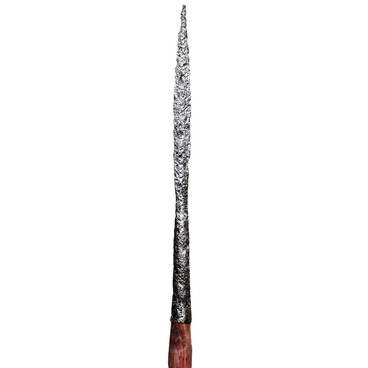The bronze leaf-shaped spearhead was found on the premises of the Bryansk Machine Building Factory in 1946 together with a shaft-hole battle axe. Researchers believe that it was a burial place of some chieftain who was traditionally buried with his weapons.
Spearhead
Creation period
Third quarter of the second millennium before Common Era
Dimensions
29,3x6x4 cm
29.3х6х4 cm
29.3х6х4 cm
Technique
Bronze, casting
Collection
Exhibition
3
Open in app#3
Spearhead
#2
#5
Both items date to the third quarter of the second millennium before Common Era. In that period, the Brynask lands were inhabited by the tribes of the Middle Dnieper archeological culture who moved here from the west and southwest. They lived in the Desna, Sudost, and Iputi river valleys.
#6
The Middle Dnieper tribes were the first in the lands of Bryansk who spoke an Indo-European language and used metal tools. Those tribes brought with them the practice of farming and cattle breeding, and the custom of kurgan burials. Most frequent archeological finds are ceramic vessels with a coil-cord decorative pattern, knives, scrapers, and spearheads.
#7
Bronze items dating to that period are rarely found by archeologists. Such alloys were not made in the Bryansk area. They were bought from the Caucasian and Balkan tribes. Hence, bronze weapons were rare and expensive and usually owned by chieftains and military commanders, and as such were perceived as symbols of power.
#8
The spearhead and the bronze shaft-hole axe were found together.
#9
The cast spearhead from the collection of the Bryansk Museum of Local History has the contour of a laurel leaf. Such a shape was meant to inflict wide and deep wounds on the enemy. Bronze is a fairly soft material. That is why the spearheads were additionally strengthened so as to prevent bending in a battle: they were made with a raised reinforcing mid rib, increasingly widening from the tip down and extending to the conical socket.
#10
The spear shaft may be up to 2 meters long. Its end was pushed into the socket and then fixed by nails or pins. The spearhead from the Bryansk collection of ancient relics has two holes intact needed for such fixing.
#11
Socketed spearheads were preceded by broadly used shanked spearheads. They had the battle section shaped in the same way, but were fixed to the spear shaft differently. Such a spearhead would have a long shank on one side hammered into the shaft. The connection point was tightened by leather bands for additional strength. However, such a connection was short-lived, and socketed spearheads quickly replaced the shanked ones.
#12
Bryansk State Regional Ethnography Museum, a State budgetary cultural institution
read morehide
00:00
00:00
1x
Spearhead
Creation period
Third quarter of the second millennium before Common Era
Dimensions
29,3x6x4 cm
29.3х6х4 cm
29.3х6х4 cm
Technique
Bronze, casting
Collection
Exhibition
3
Open in app
Share

